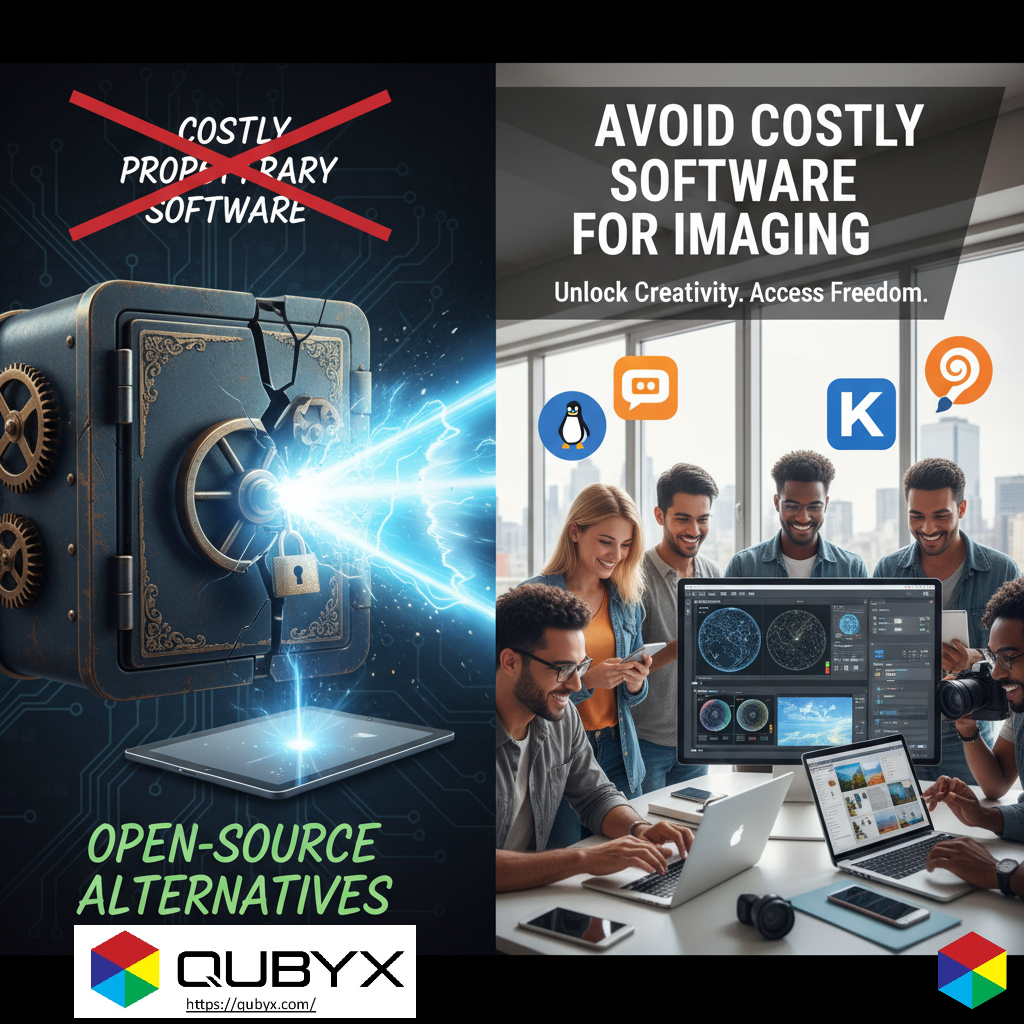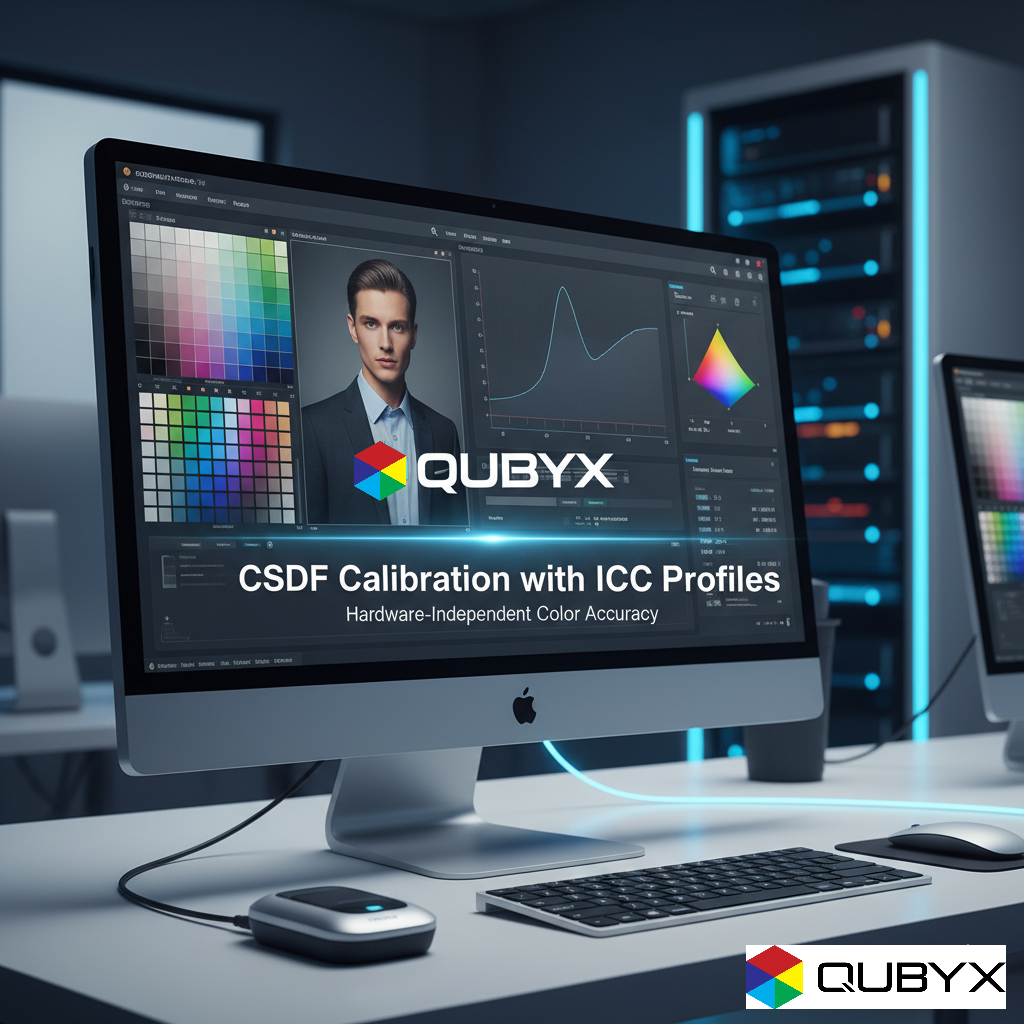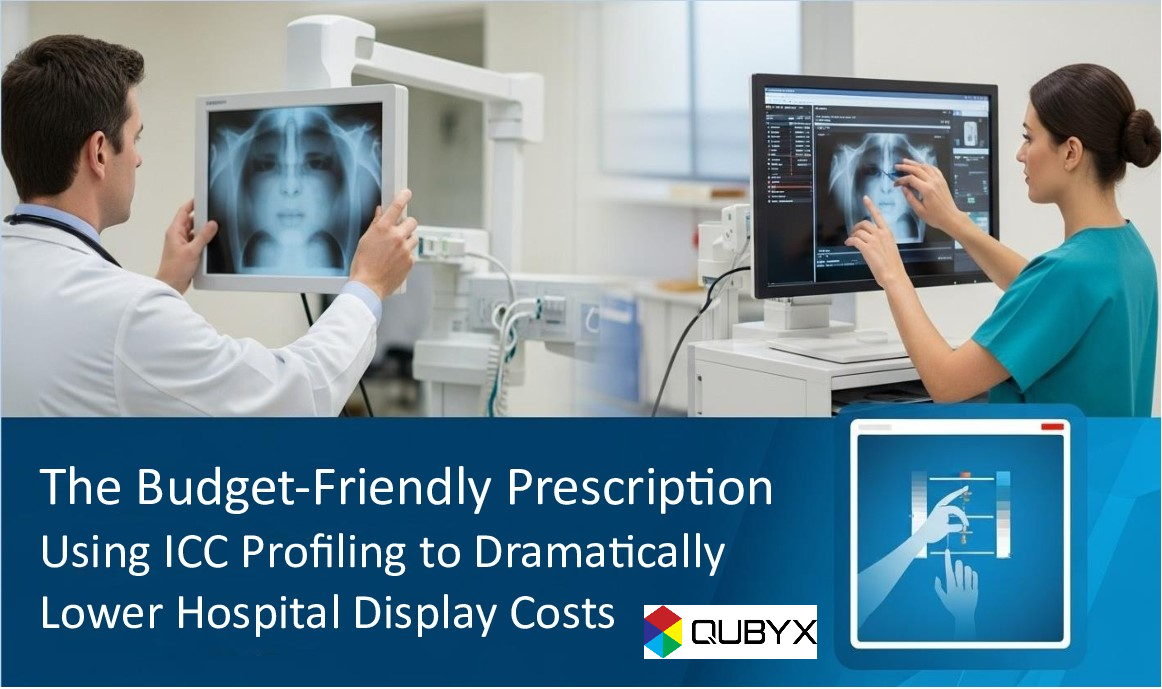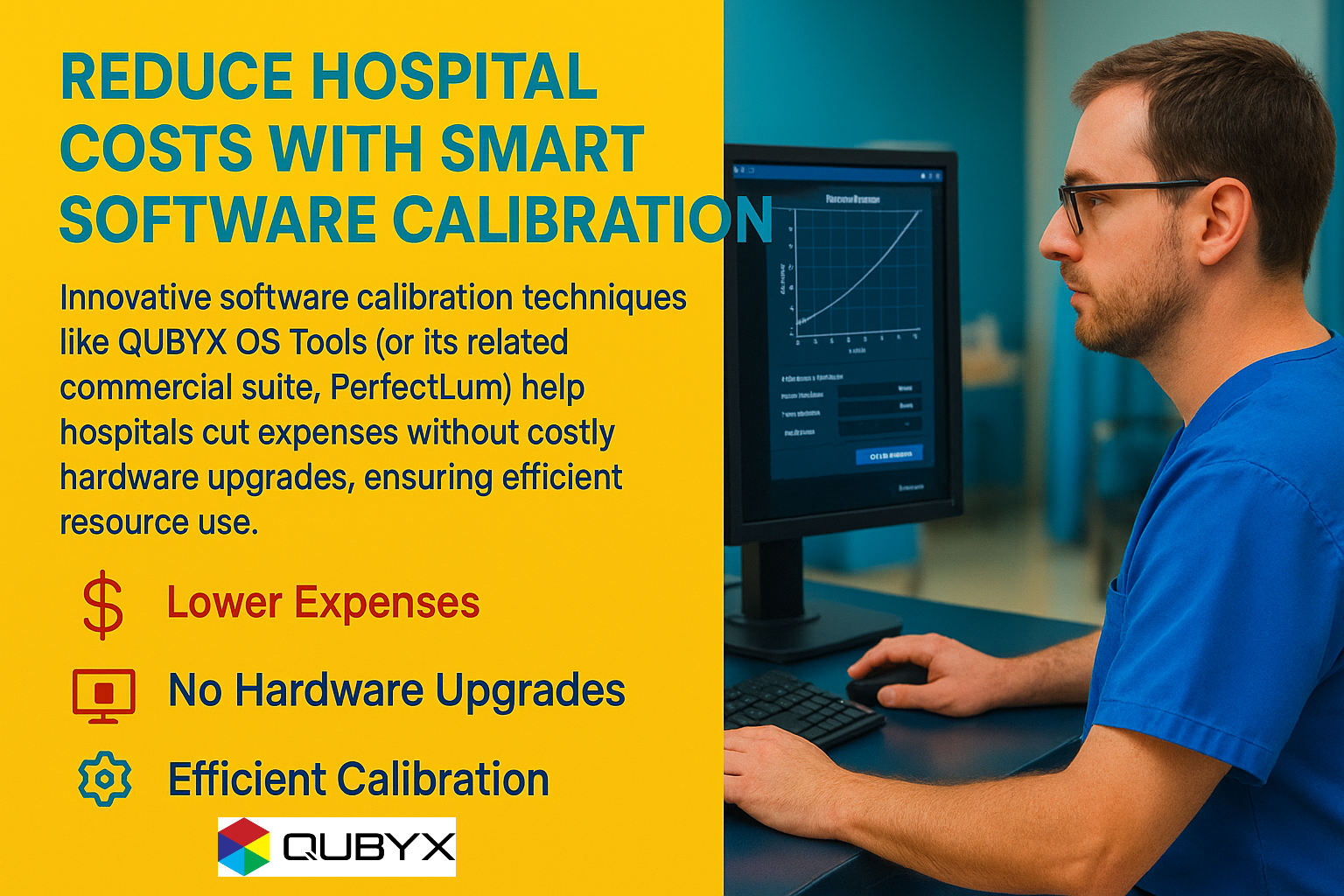News
- Home
- Avoid Costly Imaging Software & Cut Hospital Costs

Avoid Costly Imaging Software & Cut Hospital Costs
- October 8, 2025
- Shamsul
Avoid Costly Software for Imaging and Lower Hospital Cost
Why a software-first approach with QUBYX OS Tools (open-source) and PerfectLum can deliver diagnostic-grade accuracy with reduce Hospital Cost
Hospitals are under relentless pressure to do more with less and reduce hospital cost: rising imaging volumes, tighter capital budgets, and a growing need to support remote reading. In this environment, the default answer has too often been to “buy our way out”—new premium monitors, proprietary sensors, or a wholesale replacement of legacy displays. But that approach isn’t just expensive; it’s frequently unnecessary.
A smarter path is software-first calibration and quality assurance (QA). By using QUBYX OS Tools (open-source) together with the advanced PerfectLum suite, health systems can reach diagnostic-grade accuracy on cost-effective hardware, extend the lifespan of existing displays, and centralize QA—cutting operating hospital cost without compromising clinical outcomes.
The Real Cost of “Hardware-First” Imaging
Let’s unpack the hidden hospital cost that creep into imaging fleets when you rely on hardware upgrades as your primary quality lever:
-
Capital lock-in: Premium “medical-grade” monitors are excellent, but refreshing fleets every few years is a six- or seven-figure cycle for large networks.
-
Vendor dependency: Proprietary calibration devices and closed software ecosystems raise switching costs and limit innovation.
-
Operational overhead: Decentralized QA creates on-site touch time—physically visiting reading rooms to calibrate, test, and document compliance.
-
Underutilized assets: Displays that fail QA are often retired prematurely, even when a calibration curve or LUT correction could have restored performance.
In short, the traditional path burns capital and time. A software-defined approach turns this equation on its head. Thus reduce the on going hospital cost.
Software-First Calibration: How It Cuts Hospital Costs
QUBYX OS Tools (open-source) and PerfectLum champion a software-centric workflow that delivers the color and grayscale precision clinicians need while minimizing hospital cost in hardware churn.
1) Extend Display Lifespan
-
ICC/3D LUT profile generation (QUBYX OS Tools): Create advanced device-link ICC profiles and 3D LUTs to correct panel non-linearities, aging drift, and color cast—on existing monitors.
-
DICOM Part 14 GSDF conformance (PerfectLum): Apply accurate grayscale calibration tailored for radiology so legacy displays remain viable longer.
Bottom line: Fewer replacements, reduduced hospital cost, higher ROI from current assets.
2) Reduce Compliance Overhead
-
Automated calibration & QA (PerfectLum): Schedule recurring tests, luminance checks, and uniformity assessments with centralized reporting.
-
Standards alignment: Support for clinical QA frameworks (e.g., DICOM Part 14 GSDF, AAPM TG18/TG270, DIN 6868-157/-57, and common local policies) streamlines audit prep.
Bottom line: Less manual intervention, fewer on-site visits, faster audits with ruduced hospital cost.
3) Avoid Proprietary Lock-In
-
Open-source foundation (QUBYX OS Tools): Transparent pipelines you can inspect, audit, and adapt.
-
Broad sensor & display support (PerfectLum): Works with widely used colorimeters/spectros and mainstream monitors (e.g., AOC, ASUS ProArt, and others), alongside medical-grade displays.
Bottom line: Standardized, portable workflows that adapt to budget realities of the hospital cost.
4) Enable Remote & Distributed Workflows
-
Remote QA server (PerfectLum): Centrally push policies, collect results, and enforce compliance across sites and home reading setups.
-
Policy-driven consistency: Ensure every display—radiologist room, clinic, or home workstation—meets the same baseline.
Bottom line: Confidence in remote reading without duplicating premium kit everywhere.
What QUBYX OS Tools Brings (Open-Source Power)
QUBYX OS Tools is the open-source backbone that makes modern, vendor-agnostic color management possible:
-
Advanced device-link ICC profiles with embedded 3D LUTs for precise color transforms in a single profile—ideal when you need predictable, repeatable results across mixed hardware.
-
Extensible pipelines that allow technical teams to integrate calibration steps into existing PACS/enterprise imaging workflows.
-
Community-friendly licensing (open-source) encourages peer review, academic collaboration, and long-term sustainability.
This open approach democratizes professional color management, bringing sophisticated capabilities—once gated behind expensive proprietary stacks—into the mainstream with a reduced hospital cost.
What PerfectLum Adds (Enterprise-Grade QA & Automation)
PerfectLum is the enterprise engine that wraps automation, standards, and fleet management around calibration:
-
Automated DICOM GSDF calibration for grayscale accuracy in radiology.
-
Routine QA & drift monitoring with alerts and policy enforcement.
-
Uniformity and luminance checks with detailed, audit-ready reports.
-
Cross-platform support (Windows 10/11, macOS) to suit mixed IT environments.
-
Remote QA server for multi-site oversight—including home reading stations.
-
Flexible sensor support so you can use widely available colorimeters/spectros without being locked into a single vendor.
Together, QUBYX OS Tools and PerfectLum deliver a complete software-first stack—from LUT/ICC generation to automated compliance at scale.
The Financial Case: A Simple ROI Snapshot
Consider a 50-radiologist network with 120 displays:
-
Traditional refresh approach:
-
Replace 40% of displays to maintain compliance = 48 monitors
-
Average fully loaded cost per premium medical-grade monitor = $4,500
-
Capex ≈ $216,000 (not including sensors, proprietary software licenses, or field labor)
-
-
Software-first approach with QUBYX OS Tools + PerfectLum:
-
Retain 70–80% of “failing” units after calibration and QA tuning
-
Replace only truly end-of-life panels (say 10–15 units) = 10 × $4,500 = $45,000
-
Add software & minimal sensors, leverage existing hardware, centralize QA
-
Savings on first cycle: $150k–$180k+, with ongoing Opex reductions from automated QA and fewer on-site visits.
-
Your exact numbers will vary, but the order of magnitude savings—especially in the first year—are common when fleets pivot to software-defined calibration.
Clinical Quality: Precision Without Compromise
Cost control means little if image quality suffers. With a software-first stack:
-
Radiology accuracy: DICOM GSDF calibration ensures consistent grayscale response for diagnostic reading.
-
Color workflows: 3D LUT and device-link ICC profiles deliver tight color reproduction for modalities and specialties that require it (e.g., pathology, dermatology, surgical planning, cardiology cine).
-
Continuous assurance: Automated QA catches drift early, helping you fix issues before they erode clinician confidence.
The result is diagnostic-grade performance, reached through software rather than blanket hardware upgrades.
Implementation Roadmap (Fast, Safe, Repeatable)
-
Baseline Assessment
-
Inventory displays, age, usage context (primary/secondary/remote).
-
Run initial QA to identify drift, luminance shortfalls, and uniformity issues.
-
-
Pilot on Mixed Hardware
-
Use QUBYX OS Tools to generate ICC/3D LUT profiles for a representative subset (legacy + newer).
-
Apply PerfectLum to run DICOM GSDF calibration and schedule QA on the pilot group.
-
-
Policy & Automation
-
Define pass/fail thresholds per clinical context (diagnostic vs. review).
-
Schedule automated checks; configure alerts; build audit templates.
-
-
Scale Fleet-Wide
-
Roll out profiles and policies via PerfectLum Remote QA server.
-
Enable home reading stations to meet the same compliance bar.
-
-
Iterate & Optimize
-
Monitor drift trends; retire panels only when software can no longer maintain targets.
-
Standardize on a short list of cost-effective displays validated by your pipeline.
-
Governance & Compliance: Make Audits Boring Again
Regulatory scrutiny demands evidence, not anecdotes. With PerfectLum:
-
Automated logs of every calibration/QA action
-
Traceable pass/fail results aligned to standards (e.g., DICOM Part 14, AAPM TG18/TG270, DIN 6868-157/-57)
-
Centralized dashboards for physics, biomed, and IT to collaborate
When auditors arrive, you hand them a clean, comprehensive record.
IT & Biomed Benefits
-
Fewer site visits: Remote scheduling and reporting reduce “sneaker-net” support.
-
Device/vendor flexibility: Mix-and-match displays without sacrificing consistency.
-
Smoother refresh cycles: Replace only when software can’t keep a panel in spec.
-
Security & control: Policy-driven operations, minimal privilege footprints, and clear separation of roles.
Common Questions
Q: Can software really save a badly drifting panel?
A: Software can correct a lot—gamma, grayscale, LUT curves, and moderate uniformity issues. If a panel can’t meet luminance or has severe non-uniformity, it’s a candidate for replacement. The gain comes from rescuing the large middle group that’s “out of spec” but still serviceable.
Q: Is open-source safe for clinical environments?
A: Open-source is a process, not a shortcut; it enables transparency, code review, and community hardening. Pairing QUBYX OS Tools with PerfectLum’s governed, enterprise QA makes it suitable for regulated environments when deployed under your standard change controls.
Q: What about home reading quality?
A: This is where software-first shines. With PerfectLum’s remote QA and policy enforcement, you can calibrate, verify, and document home workstations to the same standard as hospital reading rooms.
Key Takeaways
-
Cut capex by extending display life and reducing unnecessary replacements.
-
Lower opex with automation, centralized QA, and fewer on-site visits.
-
Maintain diagnostic quality through DICOM GSDF calibration, ICC/3D LUT profiles, and routine QA.
-
Escape lock-in with open-source foundations and broad device support.
-
Standardize remotely across reading rooms, satellite clinics, and home setups.
Call to Action
Ready to lower hospital imaging expenses without compromising diagnostic quality?
-
Adopt a software-first stack: Use QUBYX OS Tools (open-source) to build precise ICC/3D LUT workflows.
-
Automate at scale with PerfectLum: Centralize calibration, QA, and compliance across every display you manage.
-
Start with a pilot: Pick 10–20 mixed-age displays, run the pipeline, and quantify savings and stability over 30–60 days.
Spend where it matters—on care—not on unnecessary hardware. With QUBYX OS Tools and PerfectLum, software does the heavy lifting, budgets breathe easier, and clinicians keep the precision they trust.
To secure medical-grade display precision while reducing the recurring costs of proprietary hardware, the answer is clear: transition to a software calibration platform like QUBYX OS Tools (Free) and PerfectLum today.
Tags:
imaging QA, DICOM Part 14, hospital cost reduction, display calibration, 3D LUT, ICC profiles, teleradiology QA, PerfectLum, QUBYX OS Tools, AAPM TG18, DIN 6868-157
Related Posts
- October 9, 2025
- News
CSDF Calibration with ICC Profiles | Hardware-Independent Color Accuracy by
- October 8, 2025
- News
Avoid Costly Software for Imaging and Lower Hospital Cost Why
- October 8, 2025
- News
The Budget-Friendly Prescription | Using ICC Profiling to Dramatically Lower



